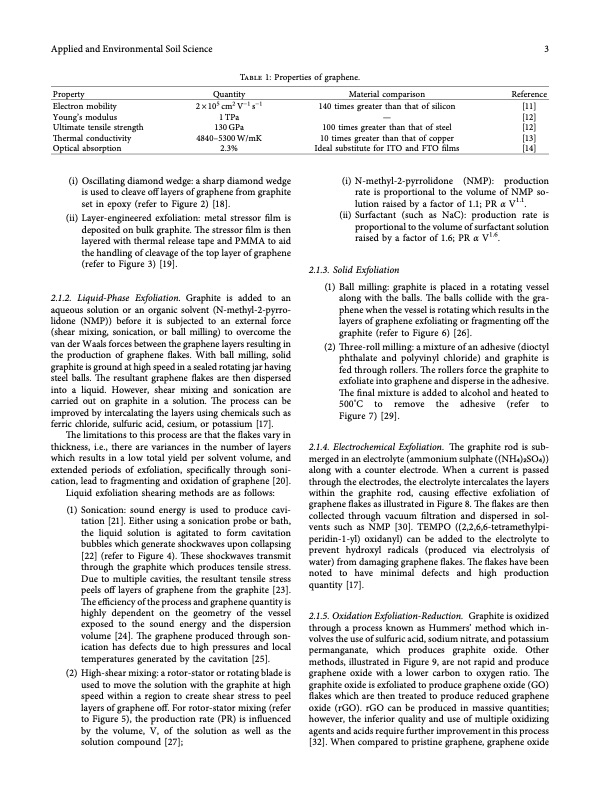
PDF Publication Title:
Text from PDF Page: 003
Applied and Environmental Soil Science 3 Property Electron mobility Young’s modulus Ultimate tensile strength Termal conductivity Optical absorption Quantity 2 × 105 cm2 V−1 s−1 1 TPa 130 GPa 4840–5300 W/mK 2.3% Material comparison 140 times greater than that of silicon — 100 times greater than that of steel 10 times greater than that of copper Ideal substitute for ITO and FTO flms Reference [11] [12] [12] [13] [14] Table 1: Properties of graphene. (i) Oscillating diamond wedge: a sharp diamond wedge is used to cleave of layers of graphene from graphite set in epoxy (refer to Figure 2) [18]. (ii) Layer-engineered exfoliation: metal stressor flm is deposited on bulk graphite. Te stressor flm is then layered with thermal release tape and PMMA to aid the handling of cleavage of the top layer of graphene (refer to Figure 3) [19]. 2.1.2. Liquid-Phase Exfoliation. Graphite is added to an aqueous solution or an organic solvent (N-methyl-2-pyrro- lidone (NMP)) before it is subjected to an external force (shear mixing, sonication, or ball milling) to overcome the van der Waals forces between the graphene layers resulting in the production of graphene fakes. With ball milling, solid graphite is ground at high speed in a sealed rotating jar having steel balls. Te resultant graphene fakes are then dispersed into a liquid. However, shear mixing and sonication are carried out on graphite in a solution. Te process can be improved by intercalating the layers using chemicals such as ferric chloride, sulfuric acid, cesium, or potassium [17]. Te limitations to this process are that the fakes vary in thickness, i.e., there are variances in the number of layers which results in a low total yield per solvent volume, and extended periods of exfoliation, specifcally through soni- cation, lead to fragmenting and oxidation of graphene [20]. Liquid exfoliation shearing methods are as follows: (1) Sonication: sound energy is used to produce cavi- tation [21]. Either using a sonication probe or bath, the liquid solution is agitated to form cavitation bubbles which generate shockwaves upon collapsing [22] (refer to Figure 4). Tese shockwaves transmit through the graphite which produces tensile stress. Due to multiple cavities, the resultant tensile stress peels of layers of graphene from the graphite [23]. Te efciency of the process and graphene quantity is highly dependent on the geometry of the vessel exposed to the sound energy and the dispersion volume [24]. Te graphene produced through son- ication has defects due to high pressures and local temperatures generated by the cavitation [25]. (2) High-shear mixing: a rotor-stator or rotating blade is used to move the solution with the graphite at high speed within a region to create shear stress to peel layers of graphene of. For rotor-stator mixing (refer to Figure 5), the production rate (PR) is infuenced by the volume, V, of the solution as well as the solution compound [27]; (i) N-methyl-2-pyrrolidone (NMP): production rate is proportional to the volume of NMP so- lution raised by a factor of 1.1; PR α V1.1. (ii) Surfactant (such as NaC): production rate is proportional to the volume of surfactant solution raised by a factor of 1.6; PR α V1.6. 2.1.3. Solid Exfoliation (1) Ball milling: graphite is placed in a rotating vessel along with the balls. Te balls collide with the gra- phene when the vessel is rotating which results in the layers of graphene exfoliating or fragmenting of the graphite (refer to Figure 6) [26]. (2) Tree-roll milling: a mixture of an adhesive (dioctyl phthalate and polyvinyl chloride) and graphite is fed through rollers. Te rollers force the graphite to exfoliate into graphene and disperse in the adhesive. Te fnal mixture is added to alcohol and heated to 500°C to remove the adhesive (refer to Figure 7) [29]. 2.1.4. Electrochemical Exfoliation. Te graphite rod is sub- merged in an electrolyte (ammonium sulphate ((NH4)2SO4)) along with a counter electrode. When a current is passed through the electrodes, the electrolyte intercalates the layers within the graphite rod, causing efective exfoliation of graphene fakes as illustrated in Figure 8. Te fakes are then collected through vacuum fltration and dispersed in sol- vents such as NMP [30]. TEMPO ((2,2,6,6-tetramethylpi- peridin-1-yl) oxidanyl) can be added to the electrolyte to prevent hydroxyl radicals (produced via electrolysis of water) from damaging graphene fakes. Te fakes have been noted to have minimal defects and high production quantity [17]. 2.1.5. Oxidation Exfoliation-Reduction. Graphite is oxidized through a process known as Hummers’ method which in- volves the use of sulfuric acid, sodium nitrate, and potassium permanganate, which produces graphite oxide. Other methods, illustrated in Figure 9, are not rapid and produce graphene oxide with a lower carbon to oxygen ratio. Te graphite oxide is exfoliated to produce graphene oxide (GO) fakes which are then treated to produce reduced graphene oxide (rGO). rGO can be produced in massive quantities; however, the inferior quality and use of multiple oxidizing agents and acids require further improvement in this process [32]. When compared to pristine graphene, graphene oxidePDF Image | State-of-the-Art Graphene Synthesis Methods

PDF Search Title:
State-of-the-Art Graphene Synthesis MethodsOriginal File Name Searched:
8475504.pdfDIY PDF Search: Google It | Yahoo | Bing
Salgenx Redox Flow Battery Technology: Power up your energy storage game with Salgenx Salt Water Battery. With its advanced technology, the flow battery provides reliable, scalable, and sustainable energy storage for utility-scale projects. Upgrade to a Salgenx flow battery today and take control of your energy future.
| CONTACT TEL: 608-238-6001 Email: greg@infinityturbine.com | RSS | AMP |